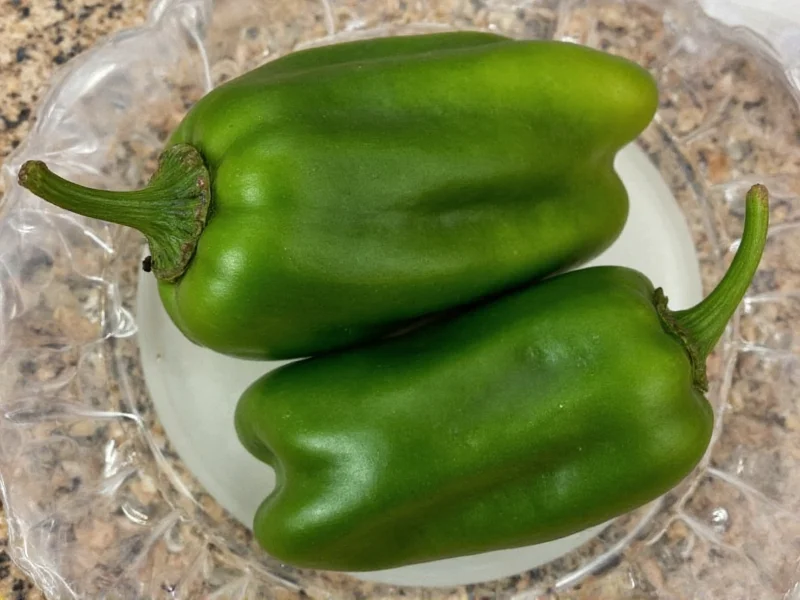When navigating Mexican cuisine ingredients, confusion between poblano and pasilla peppers is common. Understanding the distinction between these two essential chili varieties prevents recipe mishaps and enhances your culinary expertise. Let's clarify this frequent point of confusion with definitive information.
Physical Characteristics: Shape, Size, and Color
Poblano peppers are large, heart-shaped peppers with thick walls, typically measuring 4-6 inches long. When fresh, they're dark green, maturing to deep red. Pasilla peppers, by contrast, are long, narrow, and wrinkled, usually 6-8 inches in length, with a dark brown to black color when dried.
| Pepper Type | Shape | Size | Color (Fresh) | Color (Dried) | Heat Level (SHU) |
|---|---|---|---|---|---|
| Poblano | Heart-shaped, broad shoulders | 4-6 inches | Dark green | Deep red to brown (as ancho) | 1,000-2,000 |
| Pasilla | Long, narrow, wrinkled | 6-8 inches | Dark green (as chilaca) | Dark brown to black | 1,000-2,500 |
The Critical Fresh vs. Dried Confusion
The primary reason for confusion between poblano and pasilla peppers stems from misunderstanding fresh versus dried forms. Many people mistakenly believe pasilla is the dried version of poblano, but this is incorrect.
When poblano peppers are dried, they become ancho peppers—not pasillas. Pasilla peppers are actually the dried form of chilaca peppers, a completely different fresh pepper variety. This misidentification happens frequently in grocery stores and recipes, causing unnecessary substitution errors.
Flavor Profiles and Culinary Applications
Poblano peppers offer a mild, earthy flavor with subtle fruitiness when fresh. Their dried form (ancho) develops rich, sweet notes with hints of raisin and tobacco. Chefs commonly use fresh poblanos for chiles rellenos, rajas, and as a mild base for sauces.
Pasilla peppers deliver a more complex flavor profile—earthy with notes of berry, licorice, and dried fruit. Their distinctive taste makes them essential in traditional Mexican mole sauces, particularly mole negro. When seeking authentic Mexican flavors, understanding this poblano vs pasilla flavor difference proves crucial.
Heat Level Comparison: Are poblano and pasilla the same heat?
Both peppers fall in the mild to medium heat range on the Scoville scale, but with notable differences. Fresh poblanos measure 1,000-2,000 SHU, while dried anchos (their dried form) range from 1,000-1,500 SHU. Pasilla peppers typically register between 1,000-2,500 SHU.
Despite similar heat ranges, their flavor compounds differ significantly. The poblano's thicker walls contain more capsaicin in the seeds and membranes, while pasillas distribute heat more evenly throughout the thinner flesh. This affects how their heat manifests in cooking—poblanos offer more immediate heat that mellows with cooking, while pasillas provide a slower-building warmth.
Substitution Guidance: Can I use pasilla instead of poblano?
When recipes call for fresh poblanos, substituting fresh pasillas (chilacas) isn't ideal due to their different shapes and thinner walls. However, if you need to substitute dried peppers:
- For fresh poblano: Use green bell pepper with a pinch of cayenne for mild recipes, or Anaheim peppers for similar heat
- For ancho (dried poblano): Mulato peppers offer the closest flavor profile
- For pasilla: Combine equal parts ancho and guajillo peppers to approximate the complex flavor
Understanding these substitution nuances helps maintain recipe integrity when specific peppers aren't available. The key difference between poblano and pasilla peppers means they're not directly interchangeable in traditional Mexican cooking.
Growing Characteristics and Availability
Poblano plants produce large yields of thick-walled peppers that grow well in various climates. They're widely available fresh in North American grocery stores year-round. Pasilla peppers, being the dried form of chilaca peppers, are less commonly found fresh outside Mexico. Most "pasilla" labeled in US stores is actually the dried product.
When shopping for authentic Mexican ingredients, look for "chilaca" to find fresh pasilla peppers, though this labeling is rare. Most American markets sell dried pasillas in the international section, while fresh poblanos appear in the produce aisle. This availability difference further contributes to the poblano and pasilla confusion among home cooks.
Historical Context of the Misidentification
The poblano/pasilla confusion intensified when Mexican ingredients entered mainstream American cooking. Early English-language Mexican cookbooks sometimes mislabeled dried poblanos as pasillas, creating lasting confusion. Authentic Mexican culinary tradition maintains clear distinctions between these peppers, with regional recipes specifying exact varieties.
Professional chefs specializing in Mexican cuisine emphasize that understanding the difference between poblano and pasilla peppers represents fundamental knowledge for authentic preparation. This knowledge gap often separates authentic preparations from Americanized versions of traditional dishes.











 浙公网安备
33010002000092号
浙公网安备
33010002000092号 浙B2-20120091-4
浙B2-20120091-4